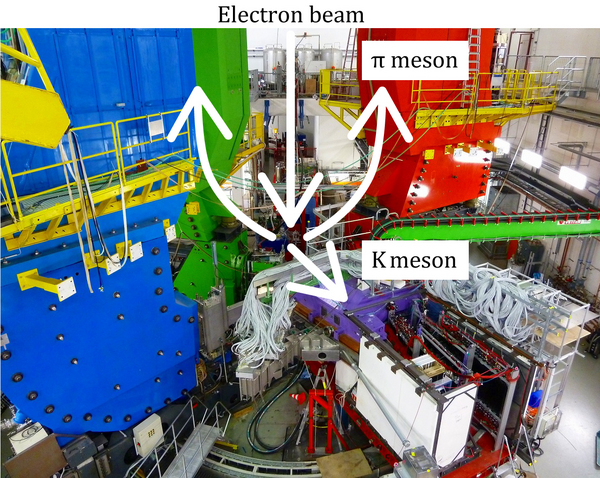NEWS
Observation of 4ΛH Hyperhydrogen by Decay-Pion Spectroscopy of Electro-produced Hypernuclei
An international collaboration group led by Prof. S. N. Nakamura (Graduate School of Science, Tohoku University), Prof. J. Pochodzalla, Dr. P. Achenbach (Mainz University) and Prof. L.Tang (Hampton University) has been developing a new experimental technique, the decay-pion spectroscopy of electro-produced hypernuclei since 2011. This technique observes pions from two-body weak-decay of hypernuclei to measure precise masses of hypernuclei.
By using this new technique for the first time worldwide, the international collaboration successfully measured the mass of which consists of one proton, two neutrons and one Λ particle. The best resolution, 540 keV(FWHM), of the mass measurement of hypernuclei was achieved at Jefferson Lab (US) for
which consists of one proton, two neutrons and one Λ particle. The best resolution, 540 keV(FWHM), of the mass measurement of hypernuclei was achieved at Jefferson Lab (US) for  using the (e,e'K+) reaction by the international collaboration led by Profs. Nakamura and Tang, however the achieved resolution by this new method is 150 keV(FWHM) which is more than three times better than the previous world record.
using the (e,e'K+) reaction by the international collaboration led by Profs. Nakamura and Tang, however the achieved resolution by this new method is 150 keV(FWHM) which is more than three times better than the previous world record.
The result was published on Physical Review Letters, 9 June 2015 (DOI: 10.1103/PhysRevLett.114.232501). This new measurement will contribute greatly to solve the puzzle of the Charge Symmetry Breaking of the Λ-N interaction.
The nuclear force which bound protons and neutrons in a nucleus was historically explained with the famous meson exchange model by Dr. H. Yukawa and now described as the low energy limit of the strong interaction based on the Quantum Chromo Dynamics. However, behavior of the strong interaction in low energy region has not yet been completely understood though many theoretical works such as Lattice QCD made great progresses. A normal nucleus consists of protons and neutrons which have charge of +e and 0, respectively. Therefore they are totally different in the electro-magnetic interaction. However the strong interaction does not distinguish proton and neutron, and the nuclear forces between them are almost the same. This feature is quite important character of the nuclear force and it is called as the Charge Symmetry of the nuclear force.
Since proton and neutron consist of up and down quarks, so we can say that all materials around us consist of up, down quarks and electons. However we can deepen our understanding of the strong interaction by adding other type of quark such as strange quark. A nucleus which contains strange quark is called as the hypernucleus and especially Lambda hypernucleus has long history of its study since 1952.
This time, the international collaboration group produced which is heavy hyper-isotope of a hydrogen nucleus by using the MAMI-C electron accelerator at Mainz University. The hyper-hydrogen
which is heavy hyper-isotope of a hydrogen nucleus by using the MAMI-C electron accelerator at Mainz University. The hyper-hydrogen  and its mirror nucleus,
and its mirror nucleus,  e which consists of two protons, one neutron and one Lambda particle were already found with nuclear emulsion in 1960s. It is known that their mass difference is extra-ordinary large even after correction of the Coulomb force. It means the strong interaction between proton and Λ is different from it between Λ and neutron. This is called as the Charge Symmetry Breaking (CSB) of the Λ-N interaction and the source of it is still mystery even now. Furthermore, recent experimental results indicate that the CSB necessary to explain the mass difference between
e which consists of two protons, one neutron and one Lambda particle were already found with nuclear emulsion in 1960s. It is known that their mass difference is extra-ordinary large even after correction of the Coulomb force. It means the strong interaction between proton and Λ is different from it between Λ and neutron. This is called as the Charge Symmetry Breaking (CSB) of the Λ-N interaction and the source of it is still mystery even now. Furthermore, recent experimental results indicate that the CSB necessary to explain the mass difference between  and
and  e cannot be applied to heavier hypernuclei and new experiments with the state-of-the-art technique are longed for.
e cannot be applied to heavier hypernuclei and new experiments with the state-of-the-art technique are longed for.
The collaboration successfully measured mass of by observing the pion from
by observing the pion from  →
→  e +π- two-body decay at MAMI-C, Mainz University. The obtained information will contribute to solve the puzzle of the Charge Symmetry Breaking of the Λ-N interaction combined with results from a planning experiment on the excited state of
e +π- two-body decay at MAMI-C, Mainz University. The obtained information will contribute to solve the puzzle of the Charge Symmetry Breaking of the Λ-N interaction combined with results from a planning experiment on the excited state of  at Jefferson Lab (US) and ongoing gamma-ray spectroscopic experiment on
at Jefferson Lab (US) and ongoing gamma-ray spectroscopic experiment on  e at J-PARC, Tokai.
e at J-PARC, Tokai.
Young researchers supported by JSPS the Strategic Young Researchers Overseas Visit Program for Accelerating Brain Circulation (R2201) and Core-to-Core program (21002) played essential roles in success of this project.
 A photo of A1 experimental hall of MAMI, Mainz University. Two large magnetic spectrometers (red and green) measure pions from decay of hypernuclei and another spectrometer (purple) tags kaons to select the events from hypernuclei.
A photo of A1 experimental hall of MAMI, Mainz University. Two large magnetic spectrometers (red and green) measure pions from decay of hypernuclei and another spectrometer (purple) tags kaons to select the events from hypernuclei.
 Pion momentum distribution tagged by kaons. A characteristic peak with the momentum of 133MeV/c from two-body decay of
Pion momentum distribution tagged by kaons. A characteristic peak with the momentum of 133MeV/c from two-body decay of  was clearly observed.
was clearly observed.
Professor Satoshi N. Nakamura
Department of Physics, Graduate School of Science, Tohoku University
E-mail: satoshi.nakamura.a7*tohoku.ac.jp (Replace * with @)
Posted on:June 25, 2015
By using this new technique for the first time worldwide, the international collaboration successfully measured the mass of
The result was published on Physical Review Letters, 9 June 2015 (DOI: 10.1103/PhysRevLett.114.232501). This new measurement will contribute greatly to solve the puzzle of the Charge Symmetry Breaking of the Λ-N interaction.
The nuclear force which bound protons and neutrons in a nucleus was historically explained with the famous meson exchange model by Dr. H. Yukawa and now described as the low energy limit of the strong interaction based on the Quantum Chromo Dynamics. However, behavior of the strong interaction in low energy region has not yet been completely understood though many theoretical works such as Lattice QCD made great progresses. A normal nucleus consists of protons and neutrons which have charge of +e and 0, respectively. Therefore they are totally different in the electro-magnetic interaction. However the strong interaction does not distinguish proton and neutron, and the nuclear forces between them are almost the same. This feature is quite important character of the nuclear force and it is called as the Charge Symmetry of the nuclear force.
Since proton and neutron consist of up and down quarks, so we can say that all materials around us consist of up, down quarks and electons. However we can deepen our understanding of the strong interaction by adding other type of quark such as strange quark. A nucleus which contains strange quark is called as the hypernucleus and especially Lambda hypernucleus has long history of its study since 1952.
This time, the international collaboration group produced
The collaboration successfully measured mass of
Young researchers supported by JSPS the Strategic Young Researchers Overseas Visit Program for Accelerating Brain Circulation (R2201) and Core-to-Core program (21002) played essential roles in success of this project.
 A photo of A1 experimental hall of MAMI, Mainz University. Two large magnetic spectrometers (red and green) measure pions from decay of hypernuclei and another spectrometer (purple) tags kaons to select the events from hypernuclei.
A photo of A1 experimental hall of MAMI, Mainz University. Two large magnetic spectrometers (red and green) measure pions from decay of hypernuclei and another spectrometer (purple) tags kaons to select the events from hypernuclei. Pion momentum distribution tagged by kaons. A characteristic peak with the momentum of 133MeV/c from two-body decay of
Pion momentum distribution tagged by kaons. A characteristic peak with the momentum of 133MeV/c from two-body decay of Contact
Professor Satoshi N. Nakamura
Department of Physics, Graduate School of Science, Tohoku University
E-mail: satoshi.nakamura.a7*tohoku.ac.jp (Replace * with @)
Posted on:June 25, 2015




